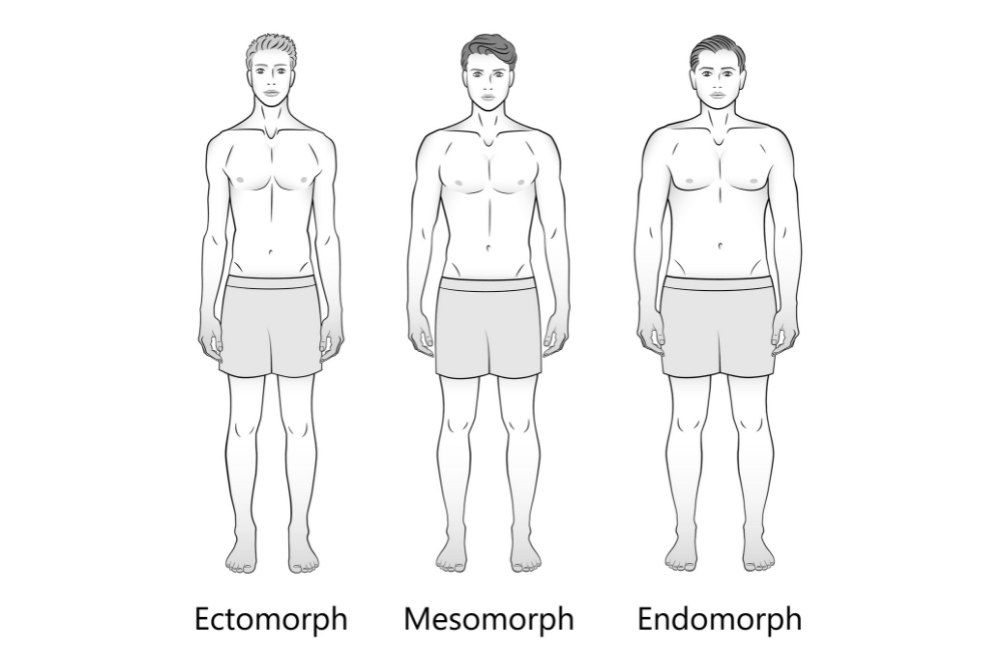
Before reading this article, you may not be familiar with the official terms related to male body types (aka somatotypes). However, you have undoubtedly met people with these different body compositions.
In general, we tend to categorize people’s body types in one of three ways.
- Short and stocky.
- Tall and lanky.
- Athletic and somewhere between the previous two extremes.
Scientifically, these three body types are known as endomorphic, ectomorphic, and mesomorphic, respectively.
But what, exactly, is the significance of these body types? Do they really matter in the long run? Let’s investigate this topic further!
Endomorphs, Ectomorphs, Mesomorphs, Oh My!
To start, it’s important to note that there is some disagreement about somatotypes.
Of course, there are individual differences in body types. But are these distinctions important? Some researchers think not. They believe these categories are not very important for us to consider.
However, somatotypes have been around for a very long time. Furthermore, many bodybuilders and trainers have made entire programs based on somatotypes. So, it’s worth discussing the topic.
The important thing to remember is that you should not despair if you fall into an unwanted somatotype. Sure, it may make it harder for you to accomplish certain exercise goals as an endomorph or an ecomorph. But this should not discourage you from working hard in the gym!
With that being said, let’s take a look at the three classic somatotypes and the characteristics of each.
Endomorph Body Type
As was mentioned in the introduction, endomorphs characteristically have each of the following attributes:
- Short and stocky frame.
- Difficulty in losing weight, and easier time gaining it.
- They may struggle with some athletic pursuits.
- “Thick” appearance of arms and legs.
For this group, it’s important to maintain a strict, disciplined diet. This is because it can be easy to pack on extra fat when they’ve “fallen off the wagon”.
However, with the proper diet and exercise plan, this group can gain muscle mass.
Mesomorph Body Type
Most people wish they had the body of a mesomorph. Unfortunately, precious few are gifted with this body type.
Mesomorphs are born athletes. These individuals are typically described in the following ways:
- They can usually gain and lose weight easily, as they desire.
- With just small tweaks to their programs, they can truly accomplish almost any goals they wish.
- They have natural strength that doesn’t disappear when they stop training.
- Sturdy, solid body frames.
Mesomorphs tend to have arms and legs that are proportional to their trunks. Without significant effort, they usually carry a good amount of muscle naturally. Also, these individuals tend to have higher resting metabolisms. This enables them to eat…pretty much whatever they want!
Ectomorph Body Type
To picture the quintessential ectomorph, picture Michael Phelps.
Specifically, ectomorphs have the following characteristics:
- They excel in sports requiring height such as swimming, volleyball, and basketball.
- Their arms and legs are often very long, making them much taller than the average person.
- They tend to be very skinny and have a lot of difficulties when trying to gain weight.
- Tall, lanky frame.
Unfortunately, these people will often have a tough time gaining muscle. Ectomorphs will often be known to eat a lot of food without any change in body composition. Therefore, this difficulty in gaining weight can be seen as the proverbial double-edged sword!
Training for Your Somatotype
If you look online, you’ll see tons of recommendations about how to train for your somatotype. Proponents for somatotype training may be able to make some strong cases for their methodology.
However, I tend to disagree with them. Furthermore, recent research seems to debunk the somatotype theory as well.
In my opinion, people should train for whatever their individual goals are, not for their somatotype.
To be clear, I don’t think that someone with a short, stocky frame can ever train in such a way as to look like an ectomorph. Also, someone with a very small, endomorphic body type may not achieve any Olympic swimming goals. But again, I don’t think this is very important for training considerations.
I tend to stick to the tried and true rules of exercise prescription.
- If you want to gain strength, you should perform lower rep sets, with heavier weights.
- If you want to improve muscle endurance and get “shredded”, consider performing higher rep sets with less weight.
- If you want to run a marathon, you should follow a program to increase your cardiovascular endurance.
Along with your training style, you should incorporate a healthy diet.
The nutritional part of the equation is, in my opinion, slightly more complicated than the exercise portion. You need to be sure that you are:
- Taking in enough calories.
- Hitting all of your macronutrient goals.
- Obtaining sufficient levels of vitamins and minerals every day.
Modifying your diet to fit your exercise goals is hard, no doubt about it!
Conclusion
Somatotyping is a way to classify individuals by body type. There are three main somatotypes and some gray areas between these types.
If you fall into a certain body type, you can’t really change this reality. However, you can still train and eat based on your goals and achieve a great physique. Furthermore, any exercise or healthy diet changes are always good things. This is true regardless of your body type!
Works Cited
- Ryan-Stewart, H., Faulkner, J., & Jobson, S. (2018). The influence of somatotype on anaerobic performance. PloS one, 13(5), e0197761. https://doi.org/10.1371/journal.pone.0197761
- Mobley CB, Haun CT, Roberson PA, Mumford PW, Kephart WC, Romero MA, Osburn SC, Vann CG, Young KC, Beck DT, Martin JS, Lockwood CM, Roberts MD. Biomarkers associated with low, moderate, and high vastus lateralis muscle hypertrophy following 12 weeks of resistance training. PLoS One. 2018 Apr 5;13(4):e0195203. doi: 10.1371/journal.pone.0195203. PMID: 29621305; PMCID: PMC5886420.


